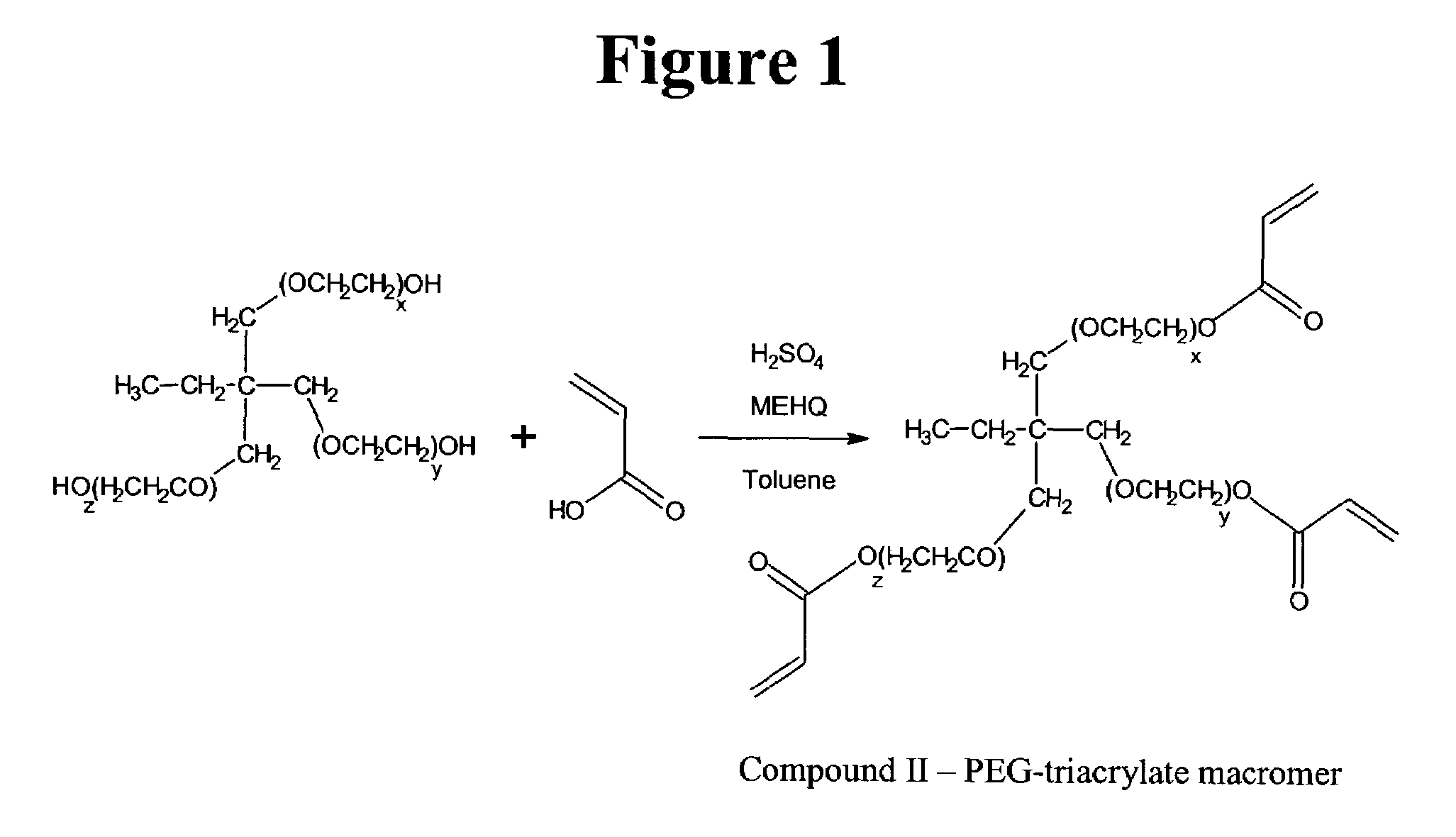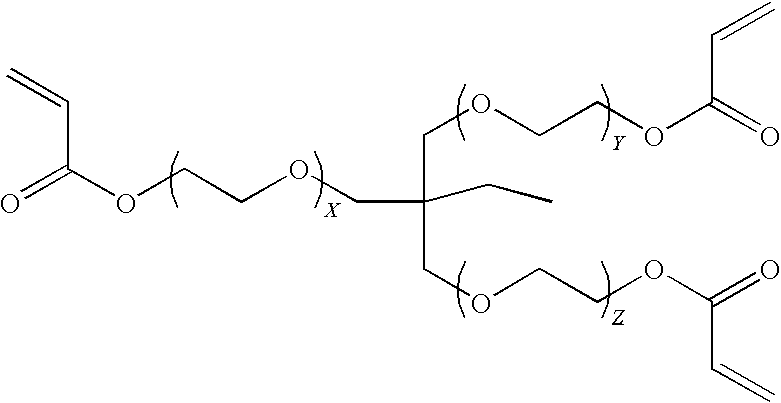Method for encapsulation of cellular material using a charged initiator polymer
a technology of initiator polymer and cellular material, which is applied in the field of compounding, can solve the problems of insufficient mechanical strength of alginate coating, formation of microcapsules, and insufficient biocompatibility, and achieve the effect of facilitating the solubility of initiator polymer and promoting the polymerization of polymeric materials
- Summary
- Abstract
- Description
- Claims
- Application Information
AI Technical Summary
Benefits of technology
Problems solved by technology
Method used
Image
Examples
example 1
Synthesis of APTAC-Polyethylenimine (APTAC-PEI) Polymer
[0074]As starting material for the preparation of a photoinitiator polymer, a positively-charged polymer having a polyethylenimine backbone coupled to cationic quaternary ammonium groups was prepared.
[0075]Quaternary ammonium groups, in the form of (acrylamidopropyl)trimethyl-ammonium chloride molecules were coupled to a polyethylenimine polymer using the following procedure: Five grams of polyethylenimine (10,000 Mw; Polysciences, Warrington, Pa.) were dissolved in 10 ml of deionized water to make a 50% PEI solution. To the 50% PEI solution was added 16 g of a 75% (3-acrylamidopropyl)-trimethylammonium chloride solution (APTAC; Simga-Aldrich Corp., St. Louis, Mo.). The mixture of PEI and APTAC was shaken overnight at 55° C. The resulting product was a viscous, amber-colored solution, which was stored in a sealed vial at room temperature.
[0076]Monitoring the vinyl protons of the APTAC molecule by NMR (Nuclear Magnetic Resonance)...
example 2
Synthesis of APTAC-EITC-Polyethylenimine (APTAC-EITC-PEI) Initiator Polymer
[0078]The positively-charged APTAC-PEI polymer synthesized in Example 1 was used as starting material for the preparation of a photoinitiator polymer having pendent photoinitiator groups.
[0079]The APTAC-PEI polymer (200 μl) as synthesized in Example 1 was dissolved in 5 ml of DMSO. Eosin-isothiocyanate (100 mg) (EITC; Helix Research, Springfield, Oreg.) was dissolved in 45 ml DMSO to make a 2.2 mM EITC solution. Solutions or reactions containing the EITC solution were subsequently performed in the dark or in light sealed containers. 5 ml of the APTAC-PEI / DMSO solution was mixed with 45 ml of the 2.2 mM EITC / DMSO solution and mixed for 24 hours at room temperature.
[0080]After 24 hours unreacted EITC was removed via ultrafiltration using two Biomax filters (5,000 Mw cutoff (MWCO); Millipore Co. Billerica, Mass.) using 2,000 mls of a 20% DMSO, 80% water solution as a wash. The next wash was performed with 2,000 ...
example 3
Preparation of APTAC-EITC-PEI Initiator Polymers of Various Molecular Weights
[0082]Using a procedure similar to that described in Examples 1 and 2, APTAC-EITC-PEI initiator polymers having variations in both (a) molecular weights and (b) EITC content were prepared.
[0083]PEI polymers having Mws of 750,000 (750K) Da, 10,000 (10K) Da, 2,000 (2K) Da, and 800 Da were obtained from Polysciences, Warrington, Pa. To prepare PEI having 50% APTAC coupling, a 2.4:1 w / w ratio of APTAC to PEI for each different sized PEI polymer was used. In to prepare PEI having 20% APTAC coupling, a 0.96:1 w / w ratio of APTAC to PEI for each different sized PEI polymer was used. Reagents and reaction times as detailed in Example 1 were used for each of the preparations. Subsequently, preparations of APTAC-PEI polymers of the recited sizes were then coupled to EITC molecules using reagents and reaction times as detailed in Example 2. Specifically, each APTAC-PEI polymer preparation (200 μl) was dissolved in 5 ml...
PUM
| Property | Measurement | Unit |
|---|---|---|
| Fraction | aaaaa | aaaaa |
| Fraction | aaaaa | aaaaa |
| Mass | aaaaa | aaaaa |
Abstract
Description
Claims
Application Information
 Login to View More
Login to View More - R&D
- Intellectual Property
- Life Sciences
- Materials
- Tech Scout
- Unparalleled Data Quality
- Higher Quality Content
- 60% Fewer Hallucinations
Browse by: Latest US Patents, China's latest patents, Technical Efficacy Thesaurus, Application Domain, Technology Topic, Popular Technical Reports.
© 2025 PatSnap. All rights reserved.Legal|Privacy policy|Modern Slavery Act Transparency Statement|Sitemap|About US| Contact US: help@patsnap.com



